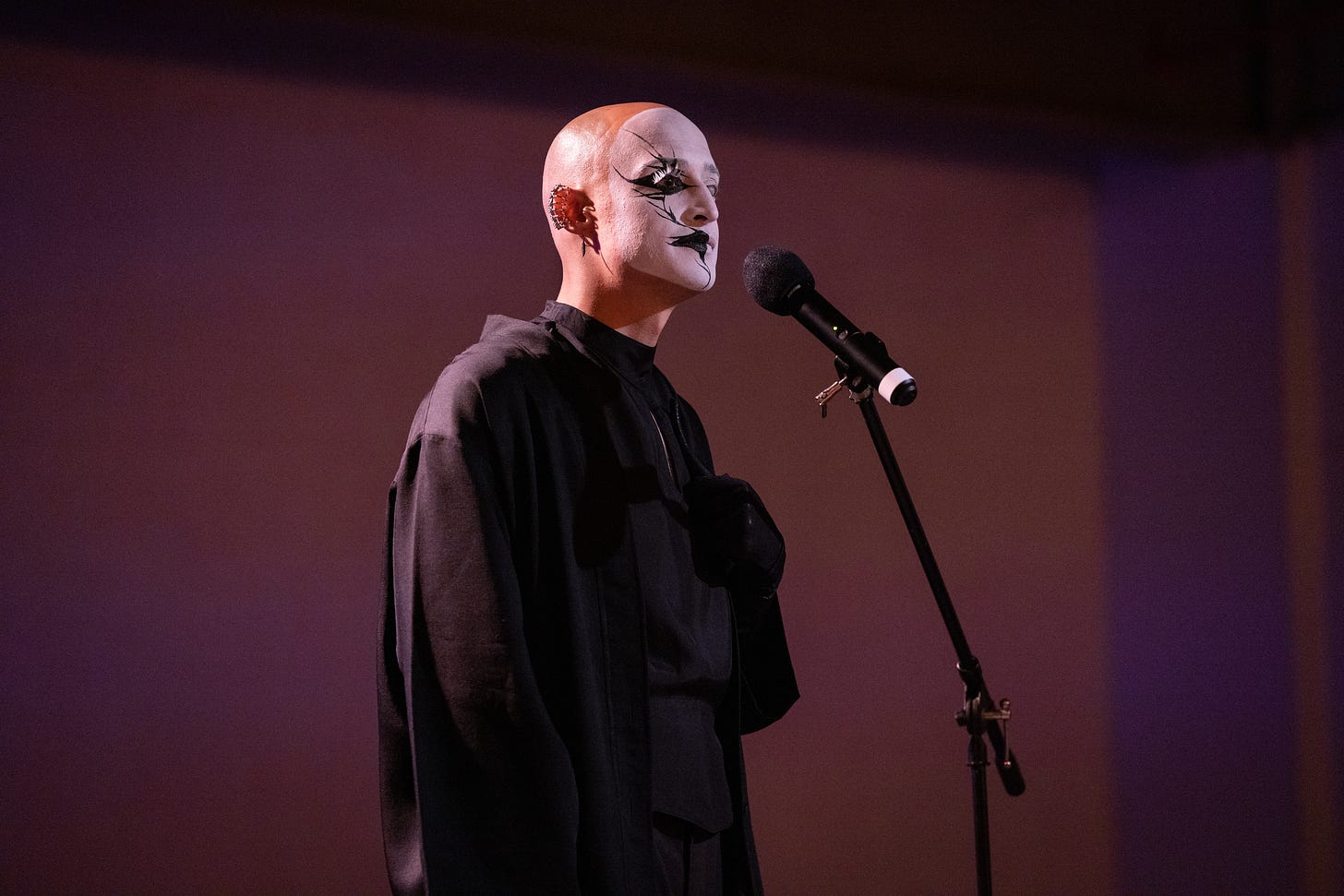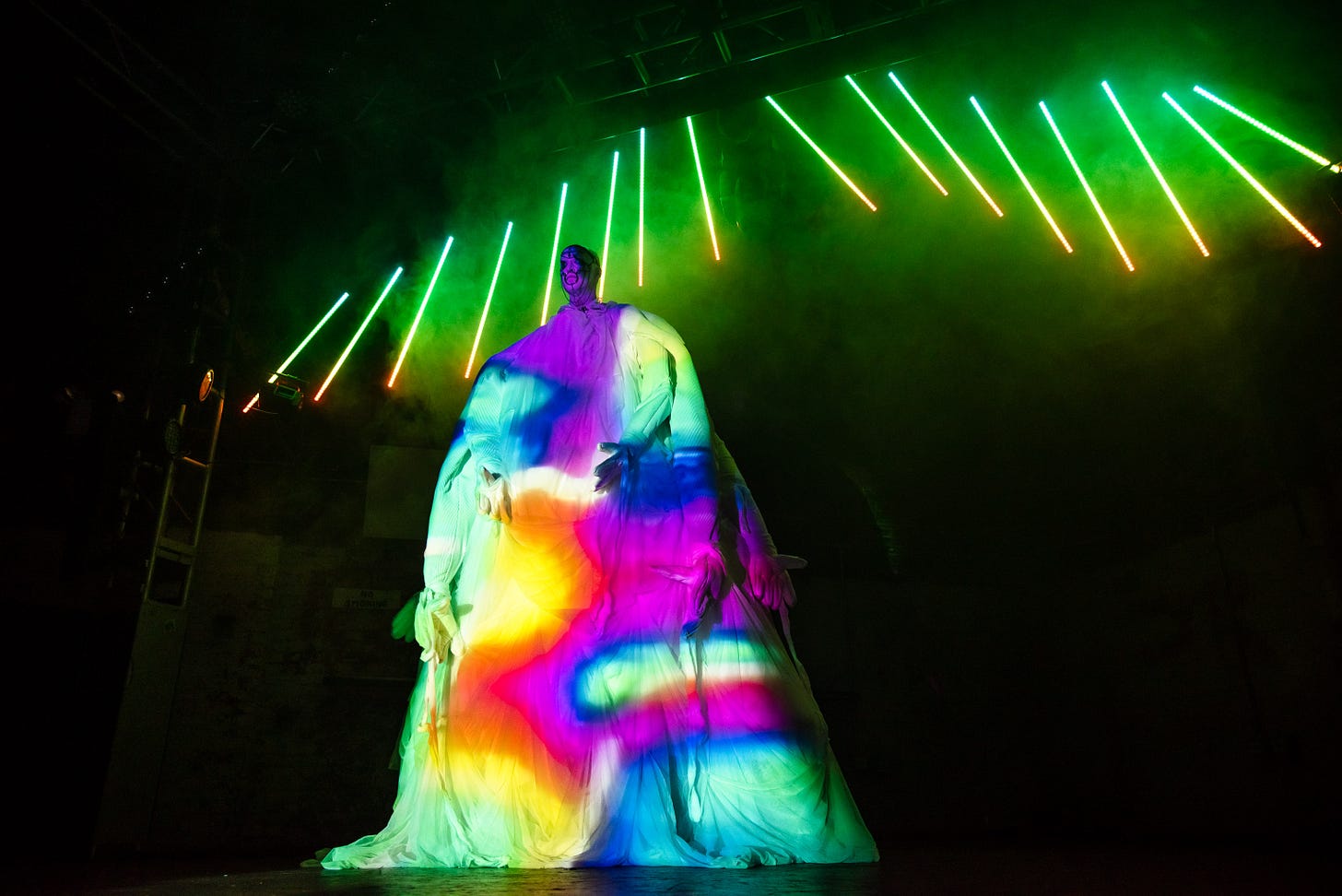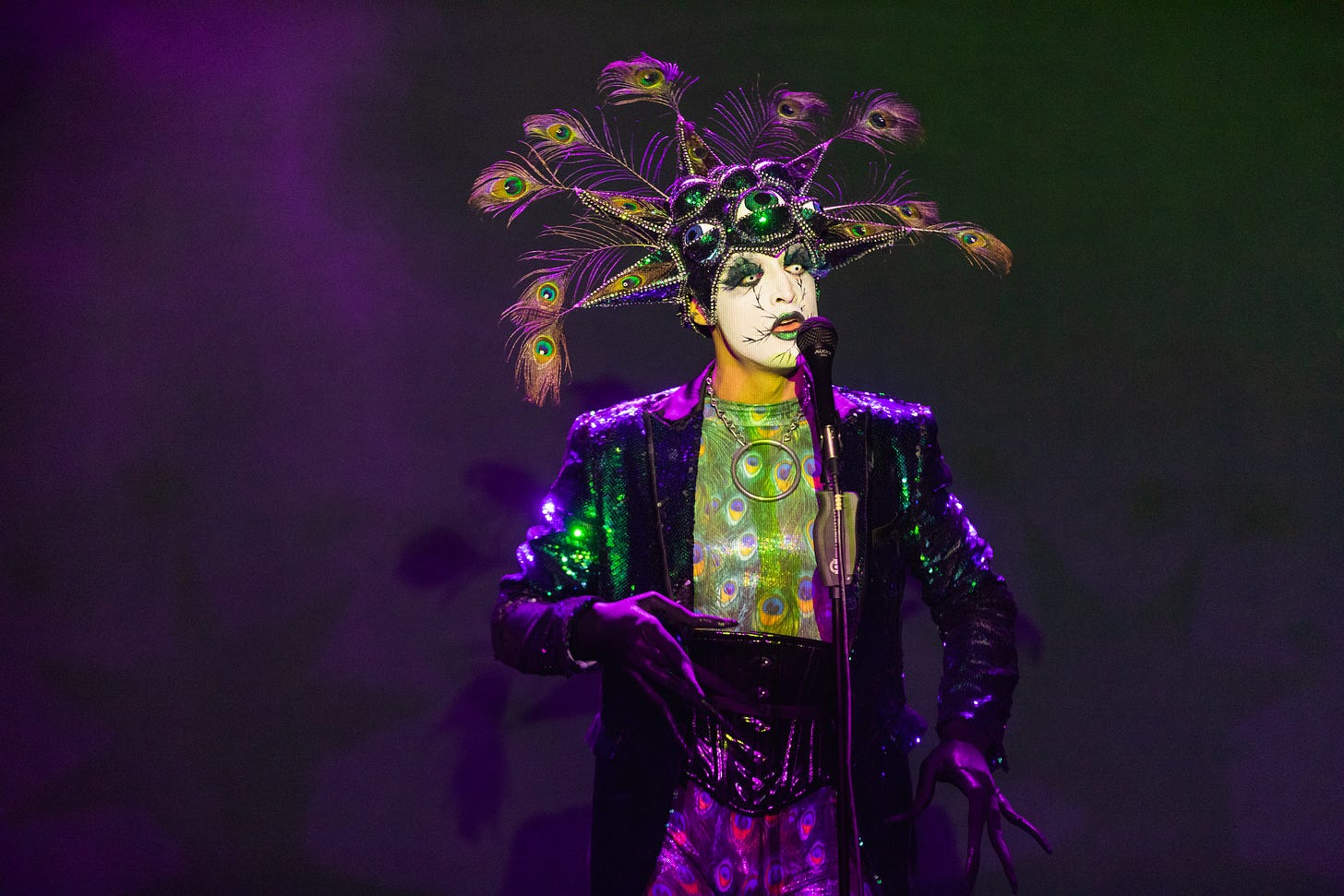You Are A Bird. You Are A Hawk. You Are A Human.
With their new show "cryptochrome," Evan Silver, aka Tiresias, completes a triptych of sensory odysseys
Upon arriving at the cell in Chelsea, you are offered two ways to experience cryptochrome. You may sit downstairs, in comfortable chairs and sofas that circle a stool and baby grand piano. Or you may go up to a balcony with a limited view of the performance, and simply lie down.
Writer, director and performer Evan Silver, aka Tiresias, crafts otherworldly musical journeys that seek to push the limits of the human senses. For cryptochrome, immersing oneself in the words and music is more important than what you see.
“There is no ‘right’ way to be here,” explains Tiresias as the show begins. “You may lie down. You may close your eyes. You may even sleep.”
Some did rest. Across from me, a woman lay across a couch, eyes closed, resembling a reclining diner from an ancient Greek vase. Upstairs, a group of younger patrons lay together as if at a slumber party.
“I mean to disarm you,” Tiresias goes on. “So that you may remember…the lost parts.”
cryptochrome invites audiences to imagine themselves as a hawk. Then as a snake. Then a mole. Also a dragonfly. Tiresias guides us through a “sonic odyssey,” placing us into the minds of organisms who sense and perceive the world in ways humans can scarcely imagine.
Silver was inspired first by the term “cryptochrome” itself. It refers to light-sensitive proteins found in the retinas of birds and other animals. Scientists have theorized that these proteins are the source of animals’ ability to navigate using the Earth’s magnetic fields — a sort of “sixth sense” that has long been identified, but never fully understood.
Silver, 29, first read about cryptochrome during the Covid-19 quarantine, while home with family in Chicago. Three years earlier, in 2017, they had been diagnosed with a degenerative eye condition. The condition will gradually degrade Silver’s eyesight over the coming years and has no cure.
“As someone just starting to figure out what it means to lose my sight as an artist, it felt really generative and interesting to me,” said Silver. “Other ways of knowing, other ways of moving through the world, modeled in the animal kingdom.”
At the same time, Silver was crafting the character of Tiresias. They had long toyed with Greek myth in their writing and directing work, and Tiresias had always intrigued: “This kind of gender-bendy, strange prophet who gets to fraternize with Gods and dance at the rites of Dionysus.”
Silver built upon their study of traditional masked performance and shadow puppetry as part of a Luce Scholarship in Bali, followed by graduate studies in London and Cambridge on a Marshall Scholarship.
It was in London, in 2019, where Silver and Emma Henry Wolf co-wrote Howl: An Odyssey, a radical adaptation of Homer’s epic poem. At that time, Silver rarely performed, but they were persuaded to play several characters — including Tiresias, the blind prophet.
Silver does not recall their own performance fondly, feeling they were not ready to explore, on stage, a diagnosis they had only begun to work through.
But later, in the “cocoon of quarantine,” Silver began envisioning a new triptych of works, all three led by Tiresias. Each idea started with a single word. There was Hyperfantasia, a medical condition referring to an overabundance of mental imagery. Then Underworld, the space where Silver first encountered Tiresias, and a terrain they wished to reclaim through a queer lens. And finally, cryptochrome.
The character of Tiresias debuted at The Brick Theater’s “Interrobang” New Works Festival in 2021. Silver performed an early version of Hyperfantasia, which was taking shape as a sci-fi cabaret imagining a new queer utopia. There were some growing pains.
“I can’t believe what I wore on stage, I look back and it’s mortifying,” said Silver. Tiresias wore psychedelic graphic-printed tights and thigh-high heels that nearly sent Silver toppling to the ground.
But Silver immediately connected with Theresa Buchheister, artistic director of The Brick. One evening the two wandered the East Village until 3 a.m, talking through Silver’s vision and how to shape the Tiresias persona. Silver credits Buchheister with every bit of success that has followed.
When The Brick brought Hyperfantasia back for a longer run in 2022, Silver wore a gorgeous headpiece adorned with peacock feathers which lit up. Tiresias was taking form.
Buchheister also encouraged Silver to expand to queer bars and clubs, with Tiresias serving as host. So Silver shaped Underworld into a work at the intersection of theater and nightlife, crafting a puppet-heavy “ritual celebration of monstrosity and otherness.” They have staged Underworld at 3 Dollar Bill, Purgatory and Club Cumming.
Performing as Tiresias all around New York has allowed Silver to develop an audience and find a broader artistic community. That can be helpful, they admit, when your work is so difficult to describe on paper.
But, emerging from the pandemic, Silver also wanted to move quickly — perform everywhere, meet every artistic director, say yes to everything. Their condition, they admit, played a role in that drive.
“There is definitely a sense that I don’t have the time everybody else has, with the faculties that I still have,” they said.
While Hyperfantasia and Underworld are both stylized and epic pieces, cryptochrome is a more intimate and meditative work. Tiresias often hosts special guests, but here are joined just by music director Tristan Allen on the piano. And for the first time, Silver is legible within the Tiresias character, sharing personal details about their loss of sight.
cryptochrome completes the triptych Silver first imagined during lockdown, but Tiresias’ journey will continue.
“Tiresias can be this shape-shifting oracle, this spirit guide who lulls you into an imaginative meditation or takes you on this wild adventure into the underworld,” said Silver. In exploring that multiplicity, they say, “I’ve really come into myself as Tiresias over the last two years.”







